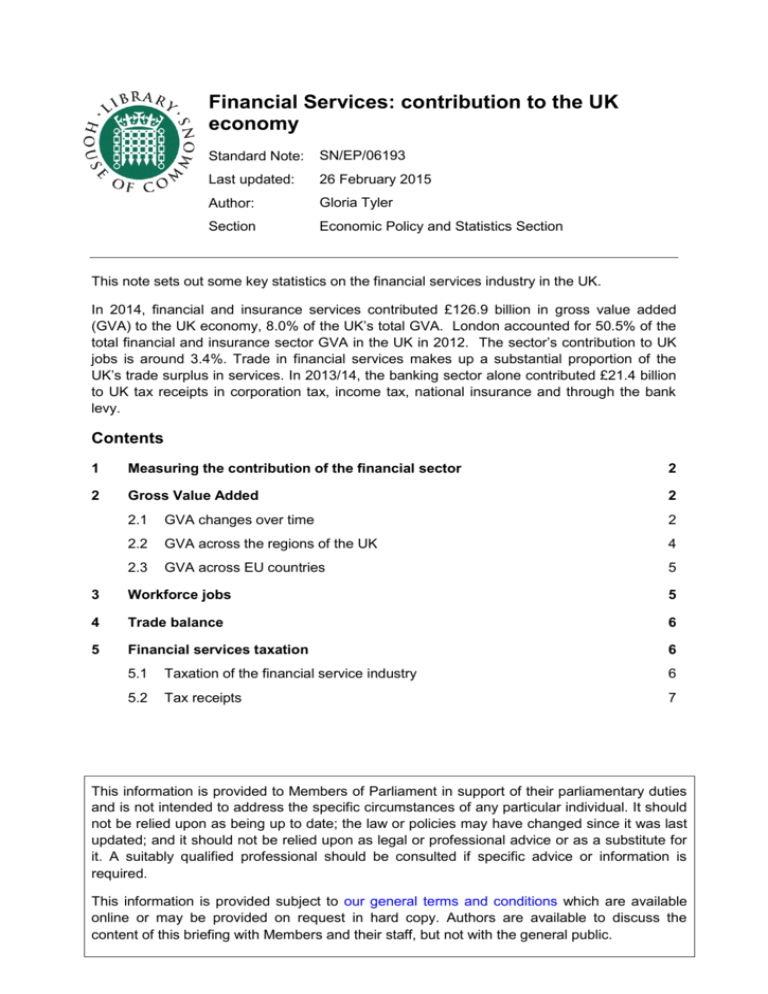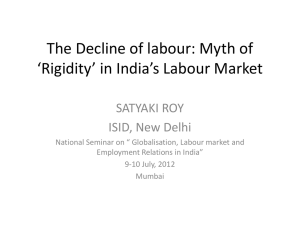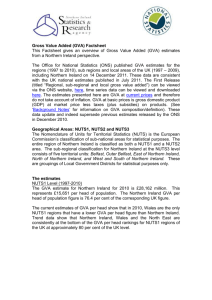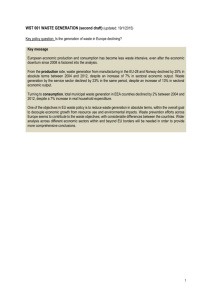The financial sector's contribution to the UK economy
advertisement

Financial Services: contribution to the UK economy Standard Note: SN/EP/06193 Last updated: 26 February 2015 Author: Gloria Tyler Section Economic Policy and Statistics Section This note sets out some key statistics on the financial services industry in the UK. In 2014, financial and insurance services contributed £126.9 billion in gross value added (GVA) to the UK economy, 8.0% of the UK’s total GVA. London accounted for 50.5% of the total financial and insurance sector GVA in the UK in 2012. The sector’s contribution to UK jobs is around 3.4%. Trade in financial services makes up a substantial proportion of the UK’s trade surplus in services. In 2013/14, the banking sector alone contributed £21.4 billion to UK tax receipts in corporation tax, income tax, national insurance and through the bank levy. Contents 1 Measuring the contribution of the financial sector 2 2 Gross Value Added 2 2.1 GVA changes over time 2 2.2 GVA across the regions of the UK 4 2.3 GVA across EU countries 5 3 Workforce jobs 5 4 Trade balance 6 5 Financial services taxation 6 5.1 Taxation of the financial service industry 6 5.2 Tax receipts 7 This information is provided to Members of Parliament in support of their parliamentary duties and is not intended to address the specific circumstances of any particular individual. It should not be relied upon as being up to date; the law or policies may have changed since it was last updated; and it should not be relied upon as legal or professional advice or as a substitute for it. A suitably qualified professional should be consulted if specific advice or information is required. This information is provided subject to our general terms and conditions which are available online or may be provided on request in hard copy. Authors are available to discuss the content of this briefing with Members and their staff, but not with the general public. 1 Measuring the contribution of the financial sector The Government has set out the need to rebalance the economy across sectors and to stimulate exports and inward investment.1 The deputy Prime Minister has said that the Government’s pro-growth agenda is about “rebalancing our economy away from an overreliance on one industry – financial services - and one area – London and the South East”.2 The current size of the financial sector is therefore relevant to the question of how reliant the UK economy is on financial services. At the same time, the current trade surplus in financial services is relevant to the issue of how best to increase UK exports. The following sections set out the sector’s contribution to the economy, the number of people employed in the sector, its contribution to the trade balance and the amount of tax it contributes to the exchequer. Measures of the financial sector usually include the activities of a wide range of firms, at the retail and wholesale level, including retail banks, building societies, investment banks and hedge funds, and are wider than the activities of financial services firms located in the City and Canary Wharf. Most measures of the size of financial services therefore also include, for example, bank branches in different areas of the country. In some cases, they also include activities related to insurance and pension funds. These statistics usually measure the contribution of the financial services and/or related sectors on a stand-alone basis. To some extent they may under-estimate the sector’s total contribution to the UK economy. This is because a well-functioning financial sector may have positive “spillover” effects for other sectors of the economy, for example, it may increase firms’ access to credit and therefore help other sectors to grow. 2 Gross Value Added Gross value added (GVA) measures the contribution of a sector to the economy, net of intermediate consumption (i.e. example, goods or services that are used in production, rather than final consumption). GVA therefore focuses on the value of a sector’s goods or services to the economy. GVA data for financial services should be used with some caution, as there is some debate as to how it should be measured, for example, what should be included and how to adjust the figures for risk.3 2.1 GVA changes over time In 2014, financial and insurance services contributed £126.9 billion in GVA to the UK economy (in cash terms), 8.0% of total value added. 1 Department for Business, Innovation and Skills, Business Plan 2012-15, 31 May 2012, p2 See, for example, the Deputy Prime Minister’s Speech to MEDEF, Paris, 8 July 2011 3 See Economic and Labour Market Review, Improving the measurement of banking services in the UK National Accounts, 2007, and The Contribution of the Financial Sector: Miracle or Mirage, Bank of England, 2010 2 2 Table 1 GVA of the Financial and Insurance Services Sector, 1997-2014 £bn, 2013 prices % change % of total UK GVA 1997 73.6 - 6.6% 1998 73.4 -0.3% 6.3% 1999 70.1 -4.5% 5.9% 2000 69.2 -1.2% 5.6% 2001 71.1 2.7% 5.6% 2002 74.6 5.0% 5.7% 2003 85.2 14.1% 6.2% 2004 98.6 15.7% 7.1% 2005 115.4 17.0% 8.0% 2006 122.7 6.3% 8.3% 2007 137.0 11.7% 9.0% 2008 120.5 -12.0% 7.9% 2009 137.0 13.7% 9.3% 2010 126.8 -7.4% 8.6% 2011 122.9 -3.1% 8.2% 2012 121.9 -0.8% 8.1% 2013 124.5 2.2% 8.2% 2014 124.4 -0.1% 8.0% Source: ONS, KKP5 and KKK9 HMT, GDP Deflator Chart 1: Percentage of GVA accounted for by financial and insurance services, 1997-2014 10% 9% 8% 7% 6% 5% 4% 3% 2% 1% 0% 1997 1999 2001 2003 2005 2007 2009 2011 2013 Financial and insurance activities have grown as a proportion of total GVA since the late 1990s and in 2014 the sector accounted for 8.0% of GVA. 3 2.2 GVA across the regions of the UK There is a wide disparity in the financial sector’s contribution to GVA across different regions of the UK. The ONS provides regional data on the financial and insurance sector. London accounted for 50.5% of the total financial and insurance sector GVA in the UK in 2012. It amounted to 18.6% of London’s total GVA. Table 2 Workplace based Financial and Insurance Activities GVA by region, 2012 £billion, 2009 prices % total UK % total financial and regional GVA insurance GVA London 60.5 18.6% 50.5% South East 11.2 5.1% 9.4% Scotland 8.2 7.2% 6.9% North West 7.9 5.8% 6.6% South West 6.8 6.1% 5.7% East of England 5.6 4.4% 4.7% Yorkshire and The Humber 5.6 5.7% 4.7% West Midlands 5.6 5.3% 4.7% East Midlands 2.9 3.3% 2.4% Wales 2.2 4.3% 1.8% North East 1.9 4.3% 1.6% Northern Ireland 1.5 4.5% 1.2% 119.8 8.2% 100.0% Total Source: ONS, Regional Gross Value Added, December 2014 4 2.3 GVA across EU countries The OECD provides data on GVA across a selection of countries.4 As shown in the chart below, the UK financial and insurance activities account for a large proportion of GVA compared to other countries. Chart 2 Proportion of GVA accounted for by financial and insurance sector, selected OECD countries, 2012 Luxembourg Australia Netherlands UK US Denmark Belgium Korea Chile Italy Greece Japan Czech Republic Slovenia Austria Sweden Hungary France Germany Poland Estonia Slovak Republic Mexico 0.0% 3 5.0% 10.0% 15.0% 20.0% 25.0% 30.0% Workforce jobs In September 2014 there were 1.1 million workforce jobs in the financial and insurance activities industry in the UK, 3.4% of all workforce jobs. The proportion of workforce jobs in the sector has not varied substantially over the period since 1997, peaking at 4.0% in March 2002. 4 UK data is sourced from the ONS and may not be entirely comparable with the data for the other countries which are from the OECD. 5 4 Trade balance The UK has a trade surplus in financial and insurance activities, i.e. exports exceed imports in the sector. The trade surplus has been growing as a proportion of GDP over the last two decades, and although it dropped in 2008 it has since recovered. In 2013, the surplus on insurance and pensions was £20.9 billion and £38.3 billion on financial services. These two sectors therefore account for a large proportion of the services trade balance of £78.9 billion. Chart 3 Trade surplus in financial and insurance activities % of GDP 4.0% 3.5% 3.0% 2.5% 2.0% 1.5% 1.0% 0.5% 0.0% 1997 1999 2001 2003 2005 Insurance 2007 2009 2011 2013 Finance 5 Financial services taxation 5.1 Taxation of the financial service industry In his Pre-Budget statement in December 2009, the then Chancellor, Alistair Darling, announced a new bank payroll tax. This would be a “special one-off level of 50 per cent on any individual discretionary bonus above £25,000” to be paid by the bank, not the bank employee.5 In the March 2010 Budget the Labour Government confirmed that the payroll tax would not be extended. In the coalition agreement, the Government stated that it would “introduce a banking levy”. 6 In his first Budget speech in June 2010 the Chancellor, George Osborne, said that a new levy would be introduced from January 2011 to “apply to the balance sheets of UK banks and building societies, and to the UK operations of banks abroad”. 7 Since the bank levy was first introduced, there have been a number of changes to the rates at which it is charged. The levy raised £1.6bn in 2012/13 and £2.3bn in 2012/13 and is forecast to raise £2.7bn in 201415, £2.9bn in 2015-16 and £2.8 billion each year over the following four years.8 More detailed information is available in the Library Standard Note, Taxation of Banking. 5 6 7 8 HC Deb 9 December 2009 c367 HM Government, The Coalition: our programme for government, May 2010, p9 HC Deb 22 June 2010 c176 OBR, Economic and Fiscal Outlook, Cm 8966 December 2014, Table 4.5 6 5.2 Tax receipts Her Majesty’s Revenue and Customs publishes details of the receipts from the banking sector from income tax, national insurance contributions, corporation tax, the bank payroll tax and the banking levy. Table 3 PAYE and corporation tax receipts from the banking sector £billions 2007-08 2008-09 2009-10 2010-11 2011-12 2012-13 2013-14 PAYE Corporation tax Bank Payrol tax Bank Levy 16.7 6.6 .. .. 14.0 3.9 .. .. 15.2 2.1 .. .. 17.5 3.5 3.4 .. 17.6 1.3 .. 1.6 17.8 2.2 .. 1.6 17.6 1.6 .. 2.2 Total 23.3 17.9 17.3 24.4 20.5 21.6 21.4 Source: HMRC, Pay-as-You-Earn and Corporation Tax Receipts from the banking sector, August 2014 The City of London Corporation has published estimates on financial sector tax receipts for 2013-14. This is based on research by PricewaterhouseCoopers (PWC), which collected data from financial services companies. The PWC research uses a broader measure of tax contributions compared to the OBR and HMRC. As well as income taxes, national insurance contributions and corporation taxes, this data includes VAT, business rates and other taxes. It includes both taxes paid by the sector and taxes collected on behalf of Government, for example, tax deducted from interest paid to customers by retail banks.9 This measure suggests that the financial sector contributed £65.6bn or 11.5% of total government receipts in 2013-14. 9 See The Total Tax Contribution of UK financial services, PWC, 7th ed, 2014 for more details. 7





